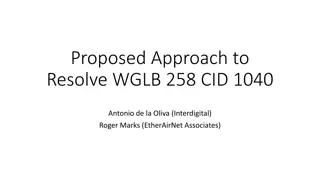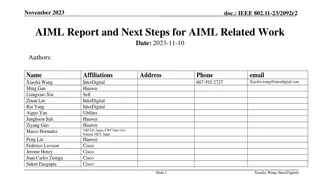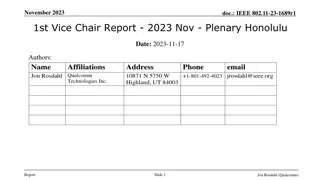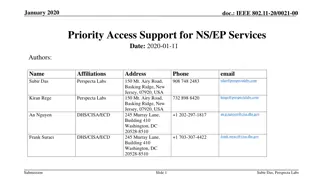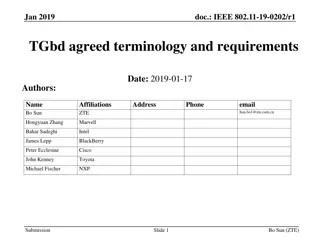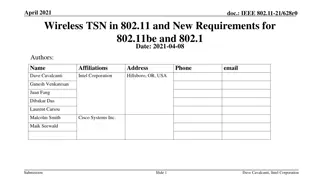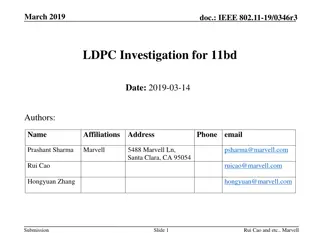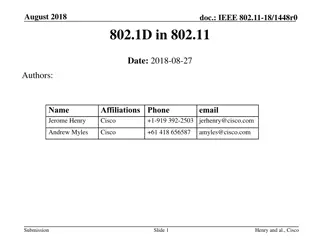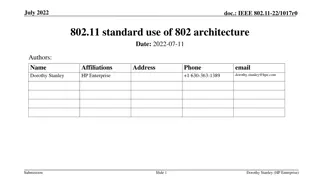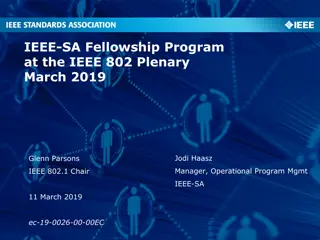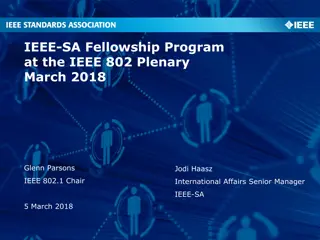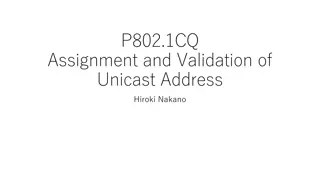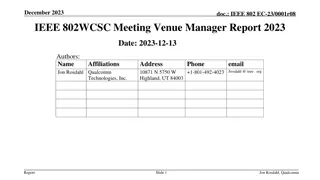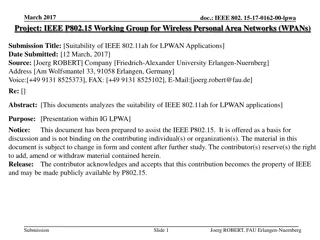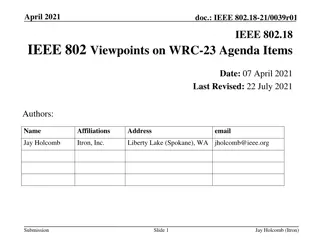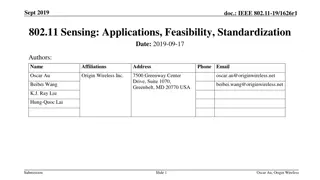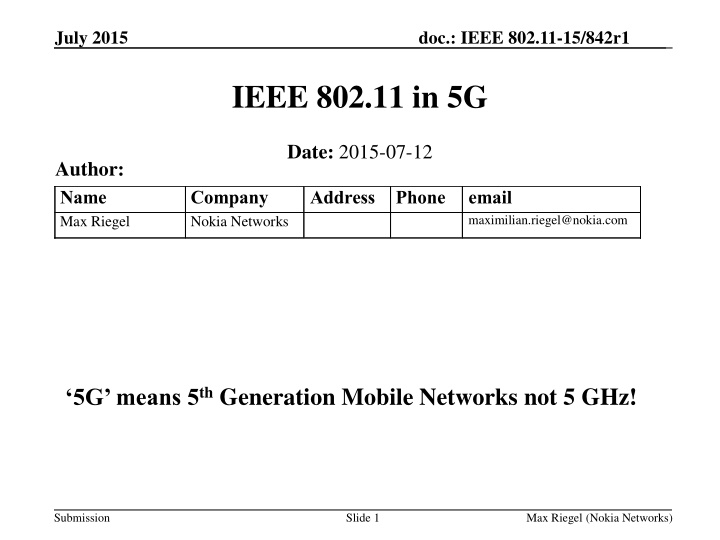
Understanding the Evolution of 5G Networks
Explore the complexities of defining 5G technology and its potential applications as presented by Max Riegel from Nokia Networks in the July 2015 IEEE document. Delve into the diverse range of requirements and visions for 5G, emphasizing the need for integration with existing technologies and the pursuit of ubiquitous connectivity with enhanced user experiences.
Download Presentation

Please find below an Image/Link to download the presentation.
The content on the website is provided AS IS for your information and personal use only. It may not be sold, licensed, or shared on other websites without obtaining consent from the author. If you encounter any issues during the download, it is possible that the publisher has removed the file from their server.
You are allowed to download the files provided on this website for personal or commercial use, subject to the condition that they are used lawfully. All files are the property of their respective owners.
The content on the website is provided AS IS for your information and personal use only. It may not be sold, licensed, or shared on other websites without obtaining consent from the author.
E N D
Presentation Transcript
July 2015 doc.: IEEE 802.11-15/842r1 IEEE 802.11 in 5G Date: 2015-07-12 Author: Name Max Riegel Company Nokia Networks Address Phone email maximilian.riegel@nokia.com 5G means 5th Generation Mobile Networks not 5 GHz! Submission Slide 1 Max Riegel (Nokia Networks)
July 2015 doc.: IEEE 802.11-15/842r1 Introduction Discussions about 5th Generation Mobile Networks have reached significant intensity in industry, academia and among mobile operators. There is no common understanding what 5G means. All agree that there is no agreement what 5G will be. A major source of current thinking might be the NGMN 5G White Paper by NGMN Alliance (February 2015) Submission Slide 2 Max Riegel (Nokia Networks)
July 2015 doc.: IEEE 802.11-15/842r1 Outline Requirements Vision Network integration Timeline assumption Current treatment of IEEE 802.11 Conclusion Submission Slide 3 Max Riegel (Nokia Networks)
July 2015 doc.: IEEE 802.11-15/842r1 A broad range of requirements are taken into account for 5G 100 Mbps whenever needed >10 Gbps peak data rates Massive Broadband 10 000 x more traffic 10-100 x more devices Capacity for everyone Ultra reliability 3D video / 4K screens Work in the cloud M2M ultra low cost Smart city cameras Flexibility for the unknown Flexibility for the unknown VR gaming Industry 4.0 10 years on battery <1 ms radio latency Remote control of robot Mission critical broadcast Massive machine type communication Critical machine type communication Sensor NW Autonomous driving # of Devices | Cost | Power (Low power) Wide area A trillion of devices with different needs Crowd Ultra-dense Outdoor GB transferred in an instant Mission-critical wireless control and automation (Source: Nokia) Submission Slide 4 Max Riegel (Nokia Networks)
July 2015 doc.: IEEE 802.11-15/842r1 Towards the 5G vision: 5G integrates well with the existing technologies 5G Architecture & mgmt Scalable service experience anytime and everywhere 5G Virtual zero latency and GB experience when and where it matters Wide area and Ultra-Dense deployments Unified solution For end user Ubiquitous connectivity + high and consistent user experience For operator Tight integration for efficient operation with cloud and SDN technologies as underlying principles 4G 3G 2G Massive mobile data and M2M Voice, video and data High quality voice and M2M Wi-Fi Fixed access Best effort data (Low power) Wide area A trillion of devices with different needs Crowd Ultra-dense Outdoor GB transferred in an instant Mission-critical wireless control and automation (Source: Nokia) Submission Slide 5 Max Riegel (Nokia Networks)
July 2015 doc.: IEEE 802.11-15/842r1 Assumptions about network integration of the various Radio Access Technologies From the NGMN Alliance 5G whitepaper: Submission Slide 6 Max Riegel (Nokia Networks)
July 2015 doc.: IEEE 802.11-15/842r1 NGMN Alliance thoughts on 5G interface options Option 1 has minimal impact to exisiting RATs but limitations to introduce full 5G performance services Option 2 allows for full evolution of network services for 5G but requires new interfacing with EPC and Fixed/Wi-Fi Option 3 would be the most comprehensive approach by integrating LTE, 5G and Fixed/Wi-Fi but has manifold implications. NGMN mandates further research into Option 3 before drawing conclusions. BTW: Currently it looks like, that initially 5G will be introduced with Option 1 and evolves in a later release into Option 2. Submission Slide 7 Max Riegel (Nokia Networks)
July 2015 doc.: IEEE 802.11-15/842r1 Timeline (assumption, no industry consensus yet) System design & pre- study Standard definition phase 1 Exploration 5G commercialization 2013 2014 2015 2016 2017 Olympics 2018 2019 2020 Olympics 2021 2022 FIFA RAN#70 Rel-12 Rel-13 Rel-14 Rel-15 Rel-16 Channel model AH 3GPP technology and architecture study items Defining of the detailed standard specifications SA1 SI RAN SI Propagation and channel modelling research WRC-19 WRC-15 (<6GHz) Industry research milestones Technology component performance understood IMT-2020 Requirements ready, industry knows how they are met Ready to commit to ITU-R requirements, evaluation criteria and scenarios that the selected components can meet 3GPP agreement on what 5G consists of (Source: Nokia) Submission Slide 8 Max Riegel (Nokia Networks)
July 2015 doc.: IEEE 802.11-15/842r1 IEEE 802.11 in 5G discussions IEEE 802.11 is present but not a focus topic 5G is mainly about a new 3GPP radio interface and its integration with LTE Integration models for IEEE 802.11 mainly based on current 3GPP approaches S2a/TWAG LWA No signs of more revolutionary discussions of integration of IEEE 802.11 in mobile networks But there are discussions about the evolution of the EPC Submission Slide 9 Max Riegel (Nokia Networks)
July 2015 doc.: IEEE 802.11-15/842r1 IEEE 802.11 in communication networks GSM/WCDMA/ LTE Wi-Fi LAN 2G/3G 4G Cable xDSL FTTH Leased Line Mobile Core CSP Backbone Internet Submission Slide 10 Max Riegel (Nokia Networks)
July 2015 doc.: IEEE 802.11-15/842r1 Conclusion There are enormous efforts behind 5G . Definition of 5G is still vague and not settled yet. It is expected that there will be standardization of a new 3GPP radio interface for ultra dense deployments with commercialization starting around 2020. IEEE 802.11 integration into 5G seems to adopt current 3GPP models for LTE. Submission Slide 11 Max Riegel (Nokia Networks)
July 2015 doc.: IEEE 802.11-15/842r1 Thank you. Comments, questions? Submission Slide 12 Adrian Stephens, Intel Corporation

